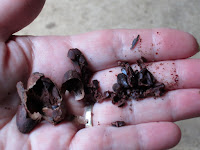In the effort to reduce my carbon "food"print, I switched my lunch from packaged apple slices that come from who knows where and are preserved in who knows what to fresh local organic apples. The truly local apples we picked in October have long since been consumed, but I did find apples from a farm 260 miles from Bergen County, NJ. That's local compared to the Washington state apples that fill the produce aisle even though apples are grown in New Jersey. The honey crisps are great with cheddar cheese produced by a small family dairy in Cape May. Water from the tap comes from the local town wells. So far I have lunch food miles down to a radius of 260 miles! And then...
 I ate a piece of chocolate. Just like that, I am impacting the rainforest again. However, there is some good news here.The cacao tree is part of the rainforest. While it may not have started as a native plant in Costa Rica, it has been growing there long enough to be considered a permanent resident, giving new meaning to green card.
I ate a piece of chocolate. Just like that, I am impacting the rainforest again. However, there is some good news here.The cacao tree is part of the rainforest. While it may not have started as a native plant in Costa Rica, it has been growing there long enough to be considered a permanent resident, giving new meaning to green card. "Farmed on over 18 million acres (7.5 million hectares) of tropical land, cocoa (Theobroma cacao) provides a means of livelihood to an estimated 40 million people, including five million farmers, 90 percent of whom are smallholders, laborers and employees in processing factories. Like coffee, cocoa can be cultivated under the shade of native canopy trees and maintain a landscape similar to natural forest. This helps conserve the habitat of threatened plant and animal species, protect natural pollinators and predators of cocoa pests and create biological corridors that maintain large-scale ecological and evolutionary processes."- Rain Forest Alliance (Use the link to read more.)
Our Toyota International Teacher Program trip to Tirimbina Biological Reserve's chocolate tour and chats with our tour guide Julio Fernandez Amon, a chocolatier, inspired an interest in the chemistry of chocolate.
 |
| Cacao beans fermenting |
 |
| Inside the cacao bean shell |
 |
| Chocolate liquor |
 |
| Steps in Processing Cacao into Chocolate |
Link for Nutrition information (note Hershey uses cocoa although cacao is preferred)
Homework
During class you explored the melting point and solubility of cocoa powder and cocoa butter. View the video at Science 360 . Then view the video below to learn more about chocolate. Finally answer the Homework Questions.
The Sweet Science of Chocolate
Homework Questions
What are the health benefits of chocolate?
Why do the health benefits depend on the type of chocolate? Use examples.
How does tempering affect the appearance of chocolate?
Use examples to explain how melting point, viscosity, and crystal growth apply to the chemistry of chocolate.
Vocabulary: melting point, viscosity, flavonoids, crystal, theobromine, caffeine, tryptophan, tempering
More to Explore
The tiny flowers of the cacao tree depend on a single species of midge (a tiny type of fly). What are the advantages and disadvantages of this type of relationship? AMNH website
Find out about fungal disease threats to cacao at the USDA website
Sequencing the Theobroma cacao genome
Research paper The Genome of Theobroma cacao
Cacao Genome Database
No comments:
Post a Comment